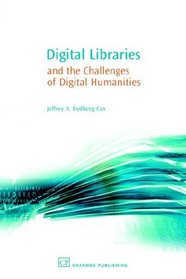Search -
Digital Libraries and the Challenges of Digital Humanities (Chandos Information Professional Series)
Digital Libraries and the Challenges of Digital Humanities - Chandos Information Professional Series
Author:
Summary: One of the major challenges facing librarians and curators of digital repositories are the innovative 'born digital' documents created by scholars in the humanities. These documents range from the parsed corpora created by linguists to traditional reference information presented in electronic databases, to rich, multi-media hypertex... more »
Author:
Summary: One of the major challenges facing librarians and curators of digital repositories are the innovative 'born digital' documents created by scholars in the humanities. These documents range from the parsed corpora created by linguists to traditional reference information presented in electronic databases, to rich, multi-media hypertex... more »
ISBN-13: 9781843341345
ISBN-10: 1843341344
Publication Date: 9/5/2005
Pages: 120
Rating: ?
ISBN-10: 1843341344
Publication Date: 9/5/2005
Pages: 120
Rating: ?
0 stars, based on 0 rating
Publisher: Chandos Publishing (Oxford) Ltd
Book Type: Paperback
Members Wishing: 0
Reviews: Amazon | Write a Review
Book Type: Paperback
Members Wishing: 0
Reviews: Amazon | Write a Review
Genres:
- Computers & Technology >> Software
- Computers & Technology >> Business Technology >> Culture
- Literature & Fiction >> Books & Reading
- Reference >> Schools & Teaching
- Reference >> Publishing & Books >> Library Management
- Nonfiction >> Social Sciences >> Library & Information Science >> General
- Nonfiction >> Social Sciences >> Library & Information Science >> Collection Development
- Nonfiction >> Social Sciences >> Library & Information Science >> Academic Libraries




